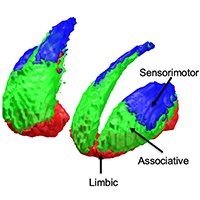Striatal topographical organization: Bridging the gap between molecules, connectivity and behavior

Accepted: 7 September 2021
HTML: 16
All claims expressed in this article are solely those of the authors and do not necessarily represent those of their affiliated organizations, or those of the publisher, the editors and the reviewers. Any product that may be evaluated in this article or claim that may be made by its manufacturer is not guaranteed or endorsed by the publisher.
Authors
The striatum represents the major hub of the basal ganglia, receiving projections from the entire cerebral cortex and it is assumed to play a key role in a wide array of complex behavioral tasks. Despite being extensively investigated during the last decades, the topographical organization of the striatum is not well understood yet. Ongoing efforts in neuroscience are focused on analyzing striatal anatomy at different spatial scales, to understand how structure relates to function and how derangements of this organization are involved in various neuropsychiatric diseases. While being subdivided at the macroscale level into dorsal and ventral divisions, at a mesoscale level the striatum represents an anatomical continuum sharing the same cellular makeup. At the same time, it is now increasingly ascertained that different striatal compartments show subtle histochemical differences, and their neurons exhibit peculiar patterns of gene expression, supporting functional diversity across the whole basal ganglia circuitry. Such diversity is further supported by afferent connections which are heterogenous both anatomically, as they originate from distributed cortical areas and subcortical structures, and biochemically, as they involve a variety of neurotransmitters. Specifically, the cortico-striatal projection system is topographically organized delineating a functional organization which is maintained throughout the basal ganglia, subserving motor, cognitive and affective behavioral functions. While such functional heterogeneity has been firstly conceptualized as a tripartite organization, with sharply defined limbic, associative and sensorimotor territories within the striatum, it has been proposed that such territories are more likely to fade into one another, delineating a gradient-like organization along medio-lateral and ventro-dorsal axes. However, the molecular and cellular underpinnings of such organization are less understood, and their relations to behavior remains an open question, especially in humans. In this review we aimed at summarizing the available knowledge on striatal organization, especially focusing on how it links structure to function and its alterations in neuropsychiatric diseases. We examined studies conducted on different species, covering a wide array of different methodologies: from tract-tracing and immunohistochemistry to neuroimaging and transcriptomic experiments, aimed at bridging the gap between macroscopic and molecular levels.
How to Cite

This work is licensed under a Creative Commons Attribution-NonCommercial 4.0 International License.
PAGEPress has chosen to apply the Creative Commons Attribution NonCommercial 4.0 International License (CC BY-NC 4.0) to all manuscripts to be published.
Similar Articles
- V. Insolia, V.M. Piccolini, Brain morphological defects in prolidase deficient mice: first report , European Journal of Histochemistry: Vol. 58 No. 3 (2014)
- A. Casini, R. Vaccaro, L. D'Este, Y. Sakaue, J.P. Bellier, H. Kimura, T.G. Renda, Immunolocalization of choline acetyltransferase of common type in the central brain mass of Octopus vulgaris , European Journal of Histochemistry: Vol. 56 No. 3 (2012)
- D. Curzi, S. Salucci, M. Marini, F. Esposito, L. Agnello, A. Veicsteinas, S. Burattini, E. Falcieri, How physical exercise changes rat myotendinous junctions: an ultrastructural study , European Journal of Histochemistry: Vol. 56 No. 2 (2012)
- H Ishida, M Kumakiri, K Ueda, LM Lao, M Yanagihara, K Asamoto, Y Imamura, S Noriki, M Fukuda, Comparative histochemical study of Bowen’s disease and actinic keratosis: preserved normal basal cells in Bowen’s disease , European Journal of Histochemistry: Vol. 45 No. 2 (2001)
- A. Mangas, J. Yajeya, N. González, I. Ruiz, M. Geffard, R. Coveñas, 3-hydroxi-anthranilic acid is early expressed in stroke , European Journal of Histochemistry: Vol. 60 No. 4 (2016)
- Arianna Casini, Romina Mancinelli, Caterina Loredana Mammola, Luigi Pannarale, Piero Chirletti, Paolo Onori, Rosa Vaccaro, Distribution of alpha-synuclein in normal human jejunum and its relations with the chemosensory and neuroendocrine system , European Journal of Histochemistry: Vol. 65 No. 4 (2021)
- Andrea Conz, Clara Alice Musi, Luca Russo, Tiziana Borsello, Luca Colnaghi, Super-resolution study of PIAS SUMO E3-ligases in hippocampal and cortical neurons , European Journal of Histochemistry: Vol. 65 No. s1 (2021): Special Collection on Advances in Neuromorphology in Health and Disease
- A. Rus, M.L. Del Moral, F. Molina, M.A. Peinado, Upregulation of cardiac NO/NOS system during short-term hypoxia and the subsequent reoxygenation period , European Journal of Histochemistry: Vol. 55 No. 2 (2011)
- L Pilloni, P Bianco, C Manieli, G Senes, P Coni, L Atzori, N Aste, G Faa, Immunoreactivity for alpha-smooth muscle actin characterizes a potentially aggressive subgroup of little basal cell carcinomas , European Journal of Histochemistry: Vol. 53 No. 2 (2009)
- A. Sbarbati, D. Accorsi, D. Benati, L. Marchetti, G. Orsini, G. Rigotti, P. Panettiere, Subcutaneous adipose tissue classification , European Journal of Histochemistry: Vol. 54 No. 4 (2010)
<< < 1 2 3 4 5 6 7 8 9 10 > >>
You may also start an advanced similarity search for this article.

 https://doi.org/10.4081/ejh.2021.3284
https://doi.org/10.4081/ejh.2021.3284










